Intro
Discover the 5 Ways Dash Diet improves heart health, reduces blood pressure, and promotes weight loss with balanced eating, sodium reduction, and nutrient-rich foods, for a healthier lifestyle.
The DASH diet, which stands for Dietary Approaches to Stop Hypertension, has been a cornerstone of healthy eating for decades. Initially designed to help lower blood pressure, it has evolved into a comprehensive dietary approach that benefits overall health and wellbeing. The core of the DASH diet focuses on whole grains, fruits, vegetables, lean protein, and low-fat dairy, aiming to reduce the intake of saturated fats and sugars. For individuals looking to adopt a healthier lifestyle, understanding the principles and benefits of the DASH diet is essential. This dietary approach not only aids in managing hypertension but also supports weight loss, improves heart health, and reduces the risk of other chronic diseases.
The importance of a well-structured diet like DASH cannot be overstated, especially in today's world where processed and high-sodium foods dominate many diets. By emphasizing nutrient-dense foods and limiting unhealthy options, the DASH diet provides a balanced and sustainable eating plan. Moreover, its flexibility and lack of strict calorie counting make it more appealing and easier to follow for many individuals compared to other diets. Whether you're aiming to lower your blood pressure, achieve a healthier weight, or simply feel more energetic, the DASH diet offers a straightforward and evidence-backed path to better health.
For those considering adopting the DASH diet, it's crucial to understand its underlying principles and how it can be tailored to meet individual nutritional needs and preferences. The diet is not about deprivation but rather about making informed choices that promote long-term health benefits. By focusing on whole, unprocessed foods and reducing intake of sugars, saturated fats, and sodium, individuals can significantly improve their overall health profile. Additionally, the DASH diet's emphasis on variety ensures that meals remain interesting and satisfying, reducing the likelihood of feeling restricted or bored with dietary choices.
Introduction to the DASH Diet
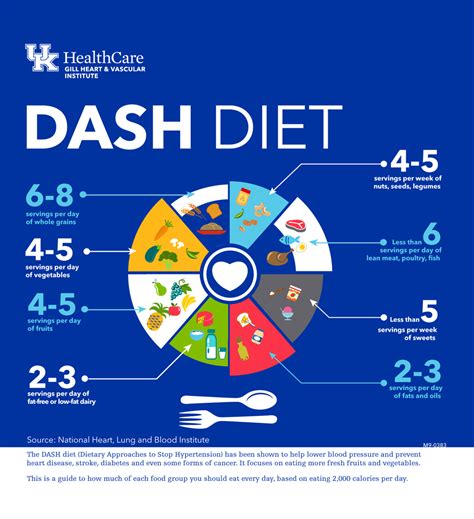
The DASH diet is grounded in scientific research, initially stemming from studies conducted in the 1990s that sought to identify dietary patterns which could help lower blood pressure. The findings led to the development of the DASH diet, which has since been refined and updated based on ongoing research. A key aspect of the DASH diet is its emphasis on eating a variety of foods from all food groups, with a particular focus on fruits, vegetables, whole grains, and lean proteins. This approach not only helps in managing blood pressure but also contributes to a balanced intake of essential nutrients, fiber, and antioxidants.
Key Components of the DASH Diet
The core components of the DASH diet include: - Fruits and vegetables: These are rich in potassium, magnesium, and fiber, which are crucial for lowering blood pressure and supporting overall health. - Whole grains: Whole grains provide fiber, vitamins, and minerals, and are recommended over refined or processed grains. - Lean proteins: Sources like poultry, fish, and legumes are preferred due to their lower fat content compared to red meats. - Low-fat dairy products: These are rich in potassium, calcium, and protein, and are recommended in moderation. - Healthy fats: Found in foods like nuts, seeds, avocados, and olive oil, these support heart health and provide essential fatty acids.Benefits of the DASH Diet
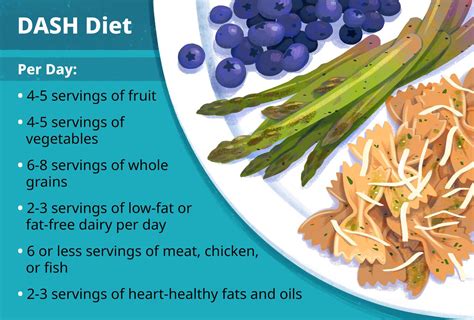
The benefits of the DASH diet are multifaceted, extending beyond blood pressure management to include weight loss, improved heart health, and reduced risk of chronic diseases like diabetes and certain cancers. By focusing on nutrient-dense foods and reducing the intake of unhealthy fats and sugars, individuals can experience significant improvements in their health and wellbeing. Moreover, the DASH diet's emphasis on whole foods makes it a more sustainable and enjoyable eating plan compared to diets that rely heavily on processed or specialty products.
Implementing the DASH Diet
Implementing the DASH diet involves making conscious choices about the foods you eat and aiming to incorporate a variety of whole, nutrient-dense foods into your meals. Here are some practical steps: - Start by increasing your intake of fruits and vegetables, aiming for at least 5 servings a day. - Incorporate whole grains into your diet, replacing refined grains with whole grain products like brown rice, quinoa, and whole wheat bread. - Choose lean proteins and healthy fats, limiting your intake of red meats and processed foods. - Limit your sodium intake, aiming for no more than 2,300 milligrams a day, and further reduce it to 1,500 milligrams if you're at risk for high blood pressure or kidney disease.5 Ways the DASH Diet Can Improve Your Health
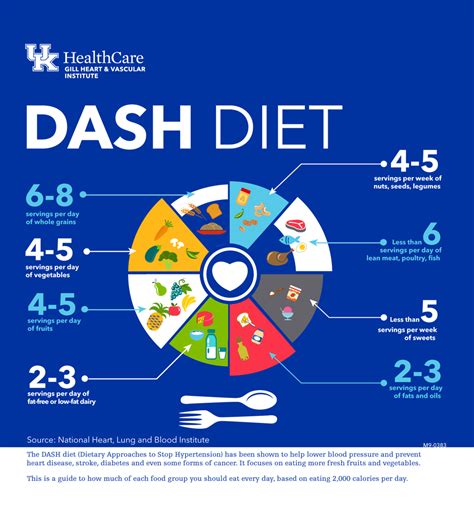
- Lowers Blood Pressure: The DASH diet is specifically designed to help lower blood pressure, which can significantly reduce the risk of heart disease, stroke, and kidney disease.
- Promotes Weight Loss: By focusing on whole, unprocessed foods and reducing intake of sugars and unhealthy fats, the DASH diet can aid in weight loss and maintenance.
- Improves Heart Health: The diet's emphasis on healthy fats, lean proteins, and fiber-rich foods helps in lowering cholesterol levels and reducing the risk of heart disease.
- Reduces Risk of Chronic Diseases: The DASH diet has been associated with a lower risk of diabetes, certain cancers, and osteoporosis, making it a valuable tool for long-term health management.
- Supports Bone Health: The inclusion of low-fat dairy products and leafy greens in the DASH diet provides essential calcium and vitamin D, supporting bone health and reducing the risk of osteoporosis.
Common Misconceptions About the DASH Diet
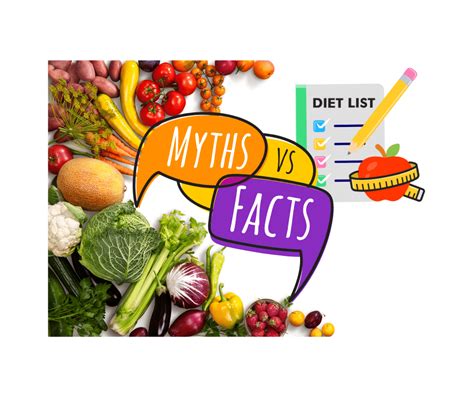
One of the common misconceptions about the DASH diet is that it's overly restrictive or boring. However, this couldn't be further from the truth. The DASH diet encourages variety and flexibility, allowing individuals to tailor their eating plan to suit their tastes and dietary needs. Another misconception is that the DASH diet is only for individuals with high blood pressure, when in fact, its principles can benefit anyone looking to adopt a healthier diet and lifestyle.
Addressing Challenges and Criticisms
Like any diet, the DASH diet has its challenges and criticisms. Some individuals may find it difficult to adjust to the reduced sodium intake or feel that the diet is too focused on restriction rather than addition. However, by understanding the underlying principles and benefits of the DASH diet, individuals can better navigate these challenges and make informed choices that support their health goals.Conclusion and Next Steps
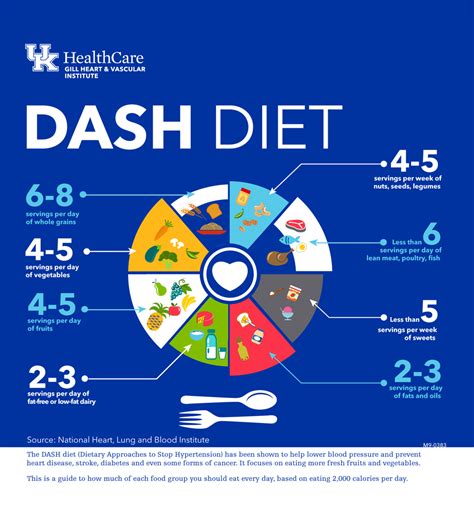
In conclusion, the DASH diet offers a comprehensive and sustainable approach to healthy eating, with benefits that extend far beyond blood pressure management. By incorporating the principles of the DASH diet into your lifestyle, you can take significant steps towards improving your overall health and wellbeing. Whether you're looking to lose weight, improve heart health, or simply feel more energetic, the DASH diet provides a flexible and evidence-backed framework for achieving your health goals.
If you found this article informative and are considering adopting the DASH diet, we encourage you to share your experiences and questions in the comments below. Additionally, feel free to share this article with friends and family who may benefit from learning more about the DASH diet and its health benefits.
What is the main goal of the DASH diet?
+The main goal of the DASH diet is to help lower blood pressure and improve overall health through dietary changes.
Can the DASH diet help with weight loss?
+Yes, the DASH diet can aid in weight loss by promoting healthy eating habits and reducing intake of unhealthy fats and sugars.
Is the DASH diet suitable for everyone?
+The DASH diet is generally suitable for most adults, but it's always a good idea to consult with a healthcare provider or dietitian before making significant changes to your diet.
